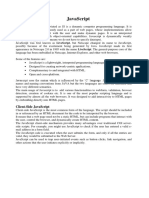JavaScript Basaic Introduction
Uploaded by
MinderJavaScript Basaic Introduction
Uploaded by
MinderJavaScript is a dynamic, high-level programming language essential for creating interactive and responsive
web content. As a core technology of the World Wide Web, alongside HTML and CSS, JavaScript is
supported by all major web browsers. Unlike Java, JavaScript is a scripting language that runs in the
browser, enabling the development of engaging web applications.
Key Features of JavaScript
1. **Client-Side Scripting**
- **Browser Execution:** JavaScript code runs directly in the user's browser, allowing for the creation
of interactive web pages without needing server-side interaction.
- **Dynamic Updates:** JavaScript enables real-time modifications to HTML and CSS, allowing for
immediate updates to the user interface based on user actions or other events.
2. **Lightweight and Interpreted**
- **Interpreted Language:** JavaScript is interpreted rather than compiled, meaning it is executed
directly by the browser’s JavaScript engine without the need for prior compilation.
- **Lightweight:** Designed to be easy to implement and run efficiently within web browsers.
3. **Event-Driven Programming**
- **Event Handling:** JavaScript excels in event-driven programming, executing code in response to
user actions like clicks, mouse movements, and keyboard inputs.
4. **Prototype-Based Object Orientation**
- **Prototypal Inheritance:** JavaScript uses prototype-based inheritance, allowing objects to inherit
properties and methods from other objects, which facilitates flexible and dynamic coding structures.
5. **Versatile Language**
- **Broad Applications:** JavaScript can be used for more than just client-side scripting. It is also
applicable for server-side development (using Node.js) and for building desktop and mobile applications.
6. **Asynchronous Programming**
- **Non-Blocking Operations:** JavaScript supports asynchronous programming through callbacks,
promises, and async/await, which is essential for tasks involving I/O operations or waiting for responses,
such as server data fetching.
7. **Compatibility with HTML and CSS**
- **Seamless Integration:** JavaScript integrates smoothly with HTML and CSS, allowing developers to
manipulate the Document Object Model (DOM) and apply styles dynamically to create rich user
experiences.
8. **Rich Ecosystem and Libraries**
- **Frameworks and Libraries:** The JavaScript ecosystem includes a variety of libraries and
frameworks, such as React, Angular, and Vue.js, which simplify and enhance the development of
complex web applications.
Basic Syntax and Structure
Here's a simple JavaScript example demonstrating its basic features:
```html
<!DOCTYPE html>
<html>
<head>
<title>JavaScript Example</title>
<script>
// Single-line comment
/* Multi-line comment */
// Function to display a greeting message
function sayHello() {
alert("Hello, World!");
// Function to change the content of a paragraph
function changeContent() {
document.getElementById("demo").innerHTML = "Content changed!";
</script>
</head>
<body>
<h1>JavaScript Example</h1>
<p id="demo">This is a paragraph.</p>
<button onclick="sayHello()">Click Me</button>
<button onclick="changeContent()">Change Content</button>
</body>
</html>
```
Explanation:
- **Comments:** JavaScript supports both single-line (`//`) and multi-line (`/* ... */`) comments for
documentation.
- **Functions:** Defined using the `function` keyword, functions can be triggered by user interactions
like button clicks.
- **DOM Manipulation:** The `document.getElementById()` method allows dynamic access and
modification of HTML elements.
- **Event Handling:** HTML attributes like `onclick` call JavaScript functions in response to user actions.
JavaScript in Web Development
JavaScript plays a crucial role in modern web development by providing various functionalities:
1. **Creating Dynamic User Interfaces**
- **Interactivity:** Enables elements like dropdowns, sliders, modals, and form validations.
- **Animations:** Facilitates the creation of animations and transitions to enhance user experience.
2. **Form Handling and Validation**
- **Client-Side Validation:** Validates user input on forms before submission to the server, improving
user experience and reducing server load.
3. **AJAX and Fetch API**
- **Asynchronous Data Loading:** Allows for asynchronous data fetching and page updates without
reloading, using AJAX and Fetch API.
4. **Single Page Applications (SPAs)**
- **Frameworks and Libraries:** JavaScript frameworks like React, Angular, and Vue.js support the
development of SPAs, where content updates dynamically without full page reloads.
5. **Server-Side Development**
- **Node.js:** Extends JavaScript to server-side programming with Node.js, enabling full-stack
development with a single language.
Conclusion
JavaScript is a versatile and powerful language integral to web development. Its capabilities for creating
interactive and dynamic web content, combined with a robust ecosystem of libraries and frameworks,
make it a top choice for developers. From simple web pages to complex applications, JavaScript offers
the tools and flexibility to build engaging and responsive user experiences.
You might also like
- 10 Places To Find Free Website Templates (With Code)No ratings yet10 Places To Find Free Website Templates (With Code)11 pages
- Buliding Interactive Web-pages With JavascriptNo ratings yetBuliding Interactive Web-pages With Javascript109 pages
- JavaScript E Notes by Er Shubham Kumar KCS052-1No ratings yetJavaScript E Notes by Er Shubham Kumar KCS052-135 pages
- Browser Scripting: Client-Server Architecture Client Side TechnologiesNo ratings yetBrowser Scripting: Client-Server Architecture Client Side Technologies9 pages
- Demystifying JavaScript Your Guide To Web Development's Essential LanguageNo ratings yetDemystifying JavaScript Your Guide To Web Development's Essential Language5 pages
- JavaScript_Full_Detailed_Notes_Complete_Extended (1)No ratings yetJavaScript_Full_Detailed_Notes_Complete_Extended (1)4 pages
- Building A Chat Application With Spring Boot and WebSocketNo ratings yetBuilding A Chat Application With Spring Boot and WebSocket12 pages
- How To Backlink - Add To Website To Directories33% (3)How To Backlink - Add To Website To Directories59 pages
- Fuerdunfiltration Com Filtro-De-Aire-Redondo-P00232p1 HTML PDF 1No ratings yetFuerdunfiltration Com Filtro-De-Aire-Redondo-P00232p1 HTML PDF 13 pages
- 7abfa941-4767-457f-86d1-878138e8b02f (1)No ratings yet7abfa941-4767-457f-86d1-878138e8b02f (1)64 pages
- 05 DAC - School - TG - Web Programming TechnologiesNo ratings yet05 DAC - School - TG - Web Programming Technologies6 pages
- Teaching and Studying Literature in The Digital Era - From Text To Hypertext (#346643) - 354651 PDFNo ratings yetTeaching and Studying Literature in The Digital Era - From Text To Hypertext (#346643) - 354651 PDF8 pages
- Sample Wordpress Tutorial: 1-Install Local Server You Can Download Appserv From HereNo ratings yetSample Wordpress Tutorial: 1-Install Local Server You Can Download Appserv From Here2 pages
- SIM7000 Series HTTPS Application Note V1.01No ratings yetSIM7000 Series HTTPS Application Note V1.0116 pages

























































































